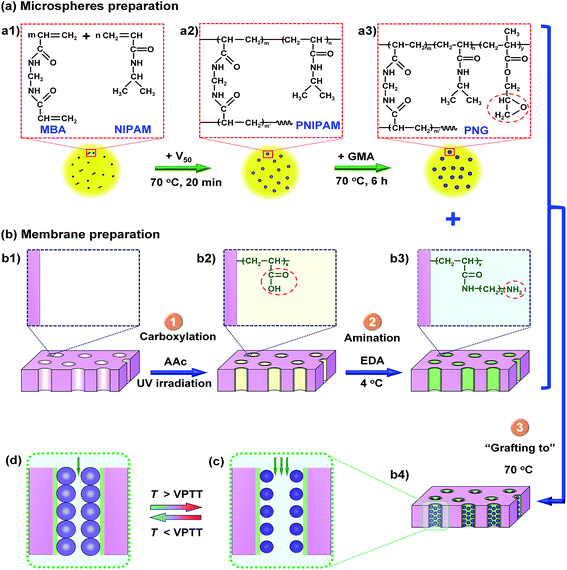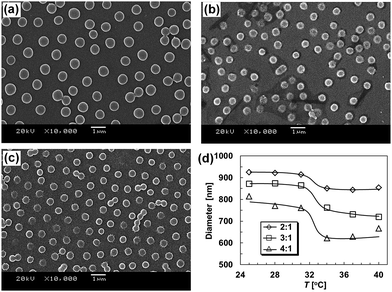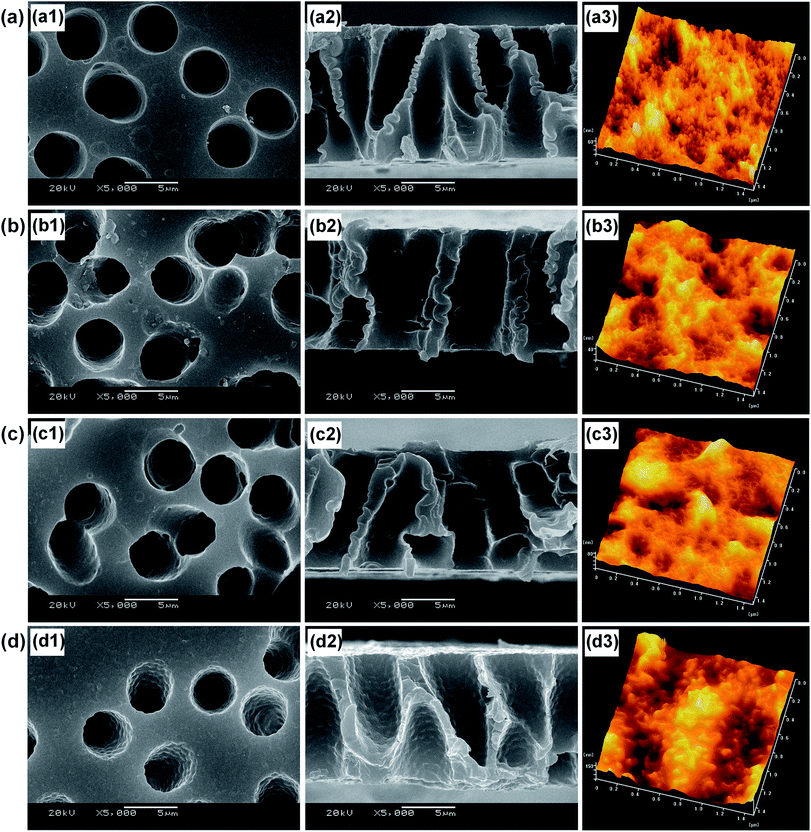Fabrication of a thermo-responsive membrane with cross-linked smart gates via a ‘grafting-to’ method†
Cheng-Jing Wua,
Rui Xie*a,
Hong-Bo Weia,
Ting-Ting Xua,
Zhuang Liua,
Wei Wanga,
Xiao-Jie Juab and
Liang-Yin Chuab
aSchool of Chemical Engineering, Sichuan University, Chengdu, Sichuan 610065, China. E-mail: xierui@scu.edu.cn
bState Key Laboratory of Polymer Materials Engineering, Sichuan University, Chengdu, Sichuan 610065, China
First published on 27th April 2016
Abstract
A novel thermo-responsive membrane was fabricated by a ‘grafting-to’ technique using cross-linked microspheres as smart gates. The resultant membrane had excellent thermo-responsive characteristics with satisfactory reversibility and stability; it showed great potential in the separation of hydrophobic molecules at high temperatures.
Thermo-responsive membranes1–3 can dramatically change their trans-membrane permeability and separation performance in response to changes in the temperature of their surroundings. They have attracted much attention in the fields of controlled drug release,4–8 bio- or chemical separation,9–11 water treatment12–14 and tissue engineering.4,15 Their thermo-responsive characteristics, stability and reversibility are influenced by their intrinsic response characteristics and the chemical and/or physical structures of the polymers, and also by the preparation method.16 To obtain thermo-responsive membranes with a desirable performance, the correct preparation method as well as the type and configuration of the thermo-responsive polymers need to be considered.
Grafting and blending thermo-responsive polymers to non-responsive membranes are the two main strategies used to obtain thermo-responsive membranes. The grafting strategy covalently bonds the thermo-responsive polymeric chains or gates to a porous membrane, usually by UV-induced grafting polymerization,17,18 plasma-induced grafting polymerization19–22 or atom-transfer radical polymerization.23,24 It provides a more permanent linkage between the substrate membrane and the anchored smart gates than in membranes fabricated by physically blending and subsequent casting.25–27
The covalent grafting of smart polymeric gates with a membrane can be accomplished by either ‘grafting-from’ or ‘grafting-to’ methods. The grafting-to technique involves the reaction of end-functionalized polymers with the complementary functional groups on the membrane, resulting in the formation of tethered polymeric chains.28,29 It is possible to regulate and characterize the responsive characteristics and polymeric structures of the smart gates, such as the chemical components, molecular weight or configuration, using this method.28 These properties affect the performance of the resultant thermo-responsive membranes. However, there have been few published reports of thermo-responsive membranes prepared using the grafting-to method.30,31 Carboxy-terminated or amino-terminated linear poly(N-isopropylacrylamide) (PNIPAM) chains have been grafted onto substrate membranes as thermo-responsive gates. However, the microstructures of the grafted membrane pores were not clearly characterized30 and the thermo-responsive characteristics of the resultant membranes were poor,31 mainly because the grafting-to process was affected by steric hindrance from the surrounding bonded chain.29
Chu and coworkers32 showed that cross-linked smart gates were more robust under high operation pressures than linear gates as a result of the cross-linked networks. However, it may be more difficult to uniformly immobilize cross-linked smart gates on the membrane by the grafting-to method because of the increased steric repulsion of the submicron-scale microspheres relative to the linear polymer chains. For this reason, thermo-responsive membranes with cross-linked smart gates prepared via the grafting-to technique have not yet been reported.
We used the grafting-to strategy to develop thermo-responsive membranes using cross-linked microspheres as smart gates. Poly(N-isopropylacrylamide-co-glycidyl methacrylate) (PNG) microspheres containing epoxy groups were copolymerized from the monomers N-isopropylacrylamide (NIPAM) and glycidyl methacrylate (GMA) in a two-step precipitation polymerization process (Fig. 1a). The aminated poly(ethylene terephthalate) (PET) membranes were fabricated by carboxylation via the grafting of acrylic acid and then amination via reaction with ethylenediamine (Fig. 1b1–b3). The PNG microspheres were then grafted to the PET membranes as cross-linked thermo-responsive gates by a chemical reaction between the epoxy groups on the PNG microspheres and the amino groups on the PET membranes (Fig. 1b4). The fabrication processes of both the PNG microspheres and the grafted membranes are described in detail in the ESI.† The configuration of the PNG microspheres dramatically changed at environmental temperatures around the volume phase transition temperature (VPTT) of the PNG microspheres. The effective pore size of the membranes decreased or increased correspondingly, resulting in a dramatic increase or decrease in the hydraulic permeability across the membrane (Fig. 1c and d). The effects of the grafting yield of the PNG microspheres and the pore size of the substrate membranes on the thermo-responsive characteristics were investigated. The potential for separating hydrophobic molecules at high temperatures was demonstrated.
 | ||
| Fig. 1 Schematic illustration of (a, b) the fabrication route and (c, d) the temperature-dependent pore size of the thermo-responsive membranes grafted with PNG microspheres as smart gates. | ||
Before being grafted onto the membranes, the size and thermo-responsive characteristics of the PNG microspheres were systematically investigated to determine the smart gates with the optimum performance. The PNG microspheres had a spherical morphology and satisfactory monodispersity in the dry state (Fig. 2a–c). The coefficient of variation33 of the diameters of microspheres was about 5% when measured over 50 microspheres for each sample. As the molar ratio of NIPAM to GMA increased, the average size of the PNG microspheres in either the dry state or in water decreased (Fig. 2) – that is, the introduction of the co-monomer GMA enlarged the size of the PNG microspheres when the feed concentration of NIPAM was kept constant. All the PNG microspheres with different molar ratios of NIPAM to GMA showed a dramatic change in volume or size at temperatures around the VPTT (ca. 32 °C) in water (Fig. 2d). At temperatures below the VPTT of the PNG microspheres, the amide groups on the PNIPAM moiety were associated with water molecules via hydrogen bonds and therefore the PNG microspheres were hydrophilic and swollen. However, as a result of the disruption of hydrogen bonds at temperatures above the VPTT, the amide groups were dissociated by the water molecules and the PNG microspheres became hydrophobic and shrank. Therefore a dramatic variation in diameter appeared at temperatures around 32 °C. However, the volume swelling to shrinking ratio of the PNG microspheres (d22/d40) decreased with increasing amounts of the GMA segment (Fig. 2d). The codes d22 and d40 refer to the hydrodynamic diameters of the PNG microspheres in water at 22 and 40 °C, respectively. The d22/d40 values of the PNG microspheres with molar ratios of NIPAM to GMA of 4![[thin space (1/6-em)]](https://www.rsc.org/images/entities/char_2009.gif) :
:![[thin space (1/6-em)]](https://www.rsc.org/images/entities/char_2009.gif) 1, 3
1, 3![[thin space (1/6-em)]](https://www.rsc.org/images/entities/char_2009.gif) :
:![[thin space (1/6-em)]](https://www.rsc.org/images/entities/char_2009.gif) 1 and 2
1 and 2![[thin space (1/6-em)]](https://www.rsc.org/images/entities/char_2009.gif) :
:![[thin space (1/6-em)]](https://www.rsc.org/images/entities/char_2009.gif) 1 were 1.25, 1.20 and 1.08, respectively. The higher the volume swelling to shrinking ratio, the better the thermo-responsive characteristics of the PNG microspheres. Therefore the PNG microspheres with a molar ratio of NIPAM to GMA of 4
1 were 1.25, 1.20 and 1.08, respectively. The higher the volume swelling to shrinking ratio, the better the thermo-responsive characteristics of the PNG microspheres. Therefore the PNG microspheres with a molar ratio of NIPAM to GMA of 4![[thin space (1/6-em)]](https://www.rsc.org/images/entities/char_2009.gif) :
:![[thin space (1/6-em)]](https://www.rsc.org/images/entities/char_2009.gif) 1 were selected for use as smart gates to fabricate the thermo-responsive membranes in the subsequent experiments.
1 were selected for use as smart gates to fabricate the thermo-responsive membranes in the subsequent experiments.
The substrate PET membrane had cylindrical and straight trans-membrane pores (Fig. 3a1 and a2). The membrane thickness and the pore size were ca. 12.6 and 5 μm, respectively. After carboxylation and amination, the morphology and microstructures of the PET membranes did not obviously change (Fig. 3b1, b2, c1 and c2). However, the average roughness (Ra) values of the membrane surfaces increased slightly compared with that of substrate membrane (Fig. 3a3, b3 and c3). This indicates that the amino groups were successfully grafted onto the membranes by carboxylation and amination. Therefore it is not surprising that the SEM images of the membrane grafted with PNG microspheres showed that the microspheres were uniformly dispersed on the top surface and in the pore walls of membranes (Fig. 3d1 and d2). The Ra value of the membrane grafted with PNG microspheres with a grafting yield (Y) of 7% increased to 24.4 nm (Fig. 3d3). The grafting yield Y of the grafted membrane is defined as the percentage increase in mass of the membrane immobilized with PNG microspheres compared with the membrane with the amino groups, as calculated by eqn S(1) in the ESI.† Because the PNG microspheres were immobilized on the membranes by the chemical reaction of the complementary groups on the microspheres and the membranes, a monolayer of PNG microspheres was formed via the proposed grafting-to method.
A series of membranes grafted with PNG microspheres with different grafting yields and different pore sizes of the original substrate membrane (d) were fabricated by the same method. Fig. 4a shows the temperature-dependent water fluxes of the membranes grafted with PNG microspheres under a constant trans-membrane pressure of 0.04 MPa. All the grafted membranes showed an abrupt change in water flux at temperatures around 32 °C, corresponding to the VPTT of the PNG microspheres (Fig. 2d). At temperatures below the VPTT, the swollen PNG microspheres led to a decrease in the pore size and, as a result, a low water flux. When the temperature increased to the VPTT, however, the PNG microspheres underwent an abrupt volume phase transition from a swollen to a shrunken state, which resulted in an increase in pore size and thus a high water flux (Fig. 1). The PNG microspheres grafted on the membrane thus adjusted the effective pore size of the membrane and, consequently, the water flux when the environmental temperature varied across the VPTT, which showed the thermo-responsive characteristics of the membranes. For the membranes with the same pore size, the water flux decreased with increasing grafting yield at the same temperature (Fig. 4a).22 At higher grafting yields, more PNG microspheres were grafted onto the membrane pores and therefore the effective pore size of the membranes became smaller.
The thermo-responsive characteristics of membranes were demonstrated by the thermo-responsive gating coefficient J40/J25, which is defined as the ratio of the measured water flux of the membranes at 40 °C to that at 25 °C. For membranes with the same pore size, the thermo-responsive gating coefficient increased with increasing grafting yield (Fig. 4b and c). The J40/J25 value of the membrane with d = 5 μm increased from 3.4, 4.2, 10.1 and 14.8 as the grafting yield increased from 4.7%, 6.3%, 7.0% and 33.2%. The thermo-responsive gating coefficients monotonically increased with increasing grafting yield, which is different from previously reported results.22,34 The thermo-responsive coefficients of membranes usually first increase and then decrease with grafting yield until the grafted polymers have filled out the membrane pores. In our study, for a monolayer of grafted PNG microspheres with a diameter <1 μm, it was impossible to fill out the 5 μm membrane pores, even if all the surface area was grafted with PNG microspheres. This was verified by the result that the J40/J25 value of membrane with d = 4 μm was higher than that of the membrane with d = 5 μm (15.9 vs. 10.1) under the same grafting yield of 7%. The results showed that both the grafting yields of the PNG microspheres and the pore size of the original substrate membrane affected the thermo-responsive characteristics of the thermo-responsive grafted membranes. The maximum normalized thermo-responsive coefficient35 for the membrane with d = 5 μm and Y = 7% was ca. 11, which is much larger than the value of 6 of the membrane blended with 17% PNIPAM nanogels.
The reversibility and stability of the thermo-responsive properties of the membrane grafted with PNG microspheres were investigated at alternate temperatures of 22 and 40 °C for five cycles of operation. The water fluxes of the grafted membrane at either 22 or 40 °C had an approximate error range <10% over five cycles (Fig. 4c) – that is, the membranes with PNG microspheres had a satisfactory reversibility and stability in their thermo-responsive performance as a result of the robust PNG microspheres firmly immobilized on the surface of the membranes.
The dynamic absorption of bovine serum albumin (BSA) molecules on the membrane with PNG microspheres was carried out at 40 °C (see the Experimental section in ESI†). The amounts of BSA adsorbed per unit membrane area (Qm) increased quickly and then slowed down over time (Fig. 4d). Compared with the amount of BSA adsorbed on the grafted membranes, the amount adsorbed on the substrate membrane can be ignored. The maximum Qm values of the smart membranes with different grafting yields were achieved within 10 min. As the grafting yield increased, the maximum Qm values of the grafted membranes increased to 13 μg cm−2 for the membrane with Y = 8.6%. This value is one order of magnitude higher than that in the previous study in which linear PNIPAM polymers were used as smart gates.11
A novel thermo-responsive membrane grafted with cross-linked microspheres as smart gates has been fabricated via a grafting-to technique. A monolayer of PNG microspheres was uniformly distributed on the surface and pore walls of PET membranes. By regulating the molar ratios of the co-monomers in the microspheres and selecting the appropriate grafting yield of the microspheres and the pore size of the original substrate membrane, the grafted membranes were shown to have excellent thermo-responsive characteristics and to be both stable and reversible. These membranes with cross-linked microspheres have great potential in the separation of hydrophobic molecules at high temperatures.
Acknowledgements
This work was primarily supported by the National Natural Science Foundation of China (20806049). The authors thank Ms Hui Wang at the Analytical and Test Center of Sichuan University for help with the SEM imaging.References
- Z. Liu, W. Wang, R. Xie, X.-J. Ju and L.-Y. Chu, Chem. Soc. Rev., 2016, 45, 460 RSC.
- A. Halperin, M. Kröger and F. M. Winnik, Angew. Chem., Int. Ed., 2015, 54, 15342 CrossRef CAS PubMed.
- D. Wandera, S. R. Wickramasinghe and S. M. Husson, J. Membr. Sci., 2010, 357, 6 CrossRef CAS.
- M. A. Ward and T. K. Georgiou, Polymers, 2011, 3, 1215 CrossRef CAS.
- W. Chen, L. Qu, D. Chang, L. Dai, S. Ganguli and A. Roy, Chem. Commun., 2008, 2, 163 RSC.
- M. A. M. E. Vertommen, H. J. L. Cornelissen, C. H. J. T. Dietz, R. Hoogenboom, M. F. Kemmere and J. T. F. Keurentjes, J. Membr. Sci., 2008, 322, 243 CrossRef CAS.
- L. Zhang, T. W. Xu and Z. Lin, J. Membr. Sci., 2006, 281, 491 CrossRef CAS.
- Q. Fan, K. K. Sirkar and J. Wu, J. Membr. Sci., 2009, 337, 175 CrossRef CAS.
- S. Darvishmanesh, X. H. Qian and S. R. Wickramasinghe, Curr. Opin. Chem. Eng., 2015, 8, 98 CrossRef.
- A. Okamura, M. Itayagoshi, T. Hagiwara, M. Yamaguchi, T. Kanamori, T. Shinbo and P. C. Wang, Biomaterials, 2005, 26, 1287 CrossRef CAS PubMed.
- T. Meng, R. Xie, Y.-C. Chen, C.-J. Cheng, P.-F. Li, X.-J. Ju and L.-Y. Chu, J. Membr. Sci., 2010, 349, 258 CrossRef CAS.
- Y. H. Xiang, Y. Z. Wang, H. B. Lin, Y. Wang, Z. Xiong and F. Liu, React. Funct. Polym., 2015, 97, 86 CrossRef CAS.
- D. Wandera, S. R. Wickramasinghe and S. M. Husson, J. Membr. Sci., 2011, 373, 178 CrossRef CAS.
- Y.-N. Wang, H.-R. Yu, R. Xie, K.-M. Zhao, X.-J. Ju, W. Wang, Z. Liu and L.-Y. Chu, Chin. J. Chem. Eng., 2016, 24, 86 CrossRef CAS.
- R. M. P. da Silva, P. M. López-Pérez, C. Elvira, J. F. Mano, J. S. Román and R. L. Reis, Biotechnol. Bioeng., 2008, 101, 1321 CrossRef CAS PubMed.
- L.-Y. Chu, R. Xie and X.-J. Ju, Chin. J. Chem. Eng., 2011, 19, 891 CrossRef CAS.
- J. P. Deng, L. F. Wang, L. Y. Liu and W. T. Yang, Prog. Polym. Sci., 2009, 34, 156 CrossRef CAS.
- C. Geismann, A. Yaroshchuk and M. Ulbricht, Langmuir, 2007, 23, 76 CrossRef CAS PubMed.
- H. Kuroki, H. Ohashi, T. Ito, T. Tamaki and T. Yamaguchi, J. Membr. Sci., 2010, 352, 22 CrossRef CAS.
- L.-Y. Chu, T. Niitsuma, T. Yamaguchi and S. Nakao, AIChE J., 2003, 49, 896 CrossRef CAS.
- R. Xie, Y. Li and L.-Y. Chu, J. Membr. Sci., 2007, 289, 76 CrossRef CAS.
- Y. Li, L.-Y. Chu, J.-H. Zhu, H.-D. Wang, S.-L. Xia and W.-M. Chen, Ind. Eng. Chem. Res., 2004, 43, 2643 CrossRef CAS.
- H. Alem, A. S. Duwez, P. Lussis, P. Lipnik, A. M. Jonas and S. Demoustier-Champagne, J. Membr. Sci., 2008, 308, 75 CrossRef CAS.
- A. Friebe and M. Ulbricht, Langmuir, 2007, 23, 10316 CrossRef CAS PubMed.
- K. Zhang, H. Y. Huang, G. C. Yang, J. Shaw, C. Yip and X. Y. Wu, Biomacromolecules, 2004, 5, 1248 CrossRef CAS PubMed.
- K. Zhang and X. Y. Wu, Biomaterials, 2004, 25, 5281 CrossRef CAS PubMed.
- G. Wang, R. Xie, X.-J. Ju and L.-Y. Chu, Chem. Eng. Technol., 2012, 35, 2015 CrossRef CAS.
- B. Zdyrko and I. Luzinov, Macromol. Rapid Commun., 2011, 32, 859 CrossRef CAS PubMed.
- P. M. Mendes, Chem. Soc. Rev., 2008, 37, 2512 RSC.
- A. Bojko, G. Andreatta, F. Montagne, P. Renau and R. Pugin, J. Membr. Sci., 2014, 468, 118 CrossRef CAS.
- B. P. Tripathi, N. C. Dubey, F. Simon and M. Stamm, RSC Adv., 2014, 4, 34073 RSC.
- Y.-C. Chen, R. Xie, M. Yang, P.-F. Li, X.-L. Zhu and L.-Y. Chu, Chem. Eng. Technol., 2009, 32, 622 CrossRef CAS.
- Y.-L. Yu, R. Xie, M.-J. Zhang, P.-F. Li, L. Yang, X.-J. Ju and L.-Y. Chu, J. Colloid Interface Sci., 2010, 346, 361 CrossRef CAS PubMed.
- M. Yang, L.-Y. Chu, Y. Li, X.-J. Zhao, H. Song and W.-M. Chen, Chem. Eng. Technol., 2006, 29, 631 CrossRef CAS.
- F. Luo, R. Xie, Z. Liu, X.-J. Ju, W. Wang, S. Lin and L.-Y. Chu, Sci. Rep., 2015, 5, 14708 CrossRef PubMed.
Footnote |
| † Electronic supplementary information (ESI) available: Experimental section including materials, the fabrication and characterization of both the PNG microspheres and grafted membranes as well as the water flux and dynamic adsorption experiments are described. See DOI: 10.1039/c6ra05192h |
| This journal is © The Royal Society of Chemistry 2016 |



